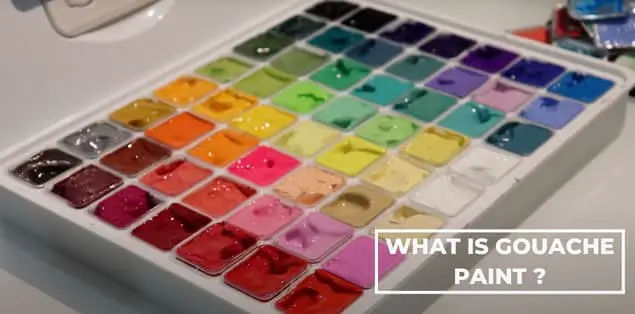If you have experimented with watercolor painting in the past or even just looked into it, there is a good possibility that you have come across the term “gouache” at some time along the route.
Gouache paint, along with acrylic and watercolor paints, is considered a kind of watermedia, which refers to a pigment, to be applied to a surface, and must be combined with water.
We often refer to gouache as an “opaque watercolor,” a “children’s poster paint,” or a supplemental medium that we may use in conjunction with other well-known painting methods. This is because we don’t use gouache as widely as other types of paint.
In this article, we’ll discuss more gouache paint.
What Is Gouache Paint?
Gouache, pronounced “gw-ash,” is similar to watercolor and acrylic paints. It is a pigment that has to be combined with water for it to be spreadable across surfaces like paper, canvas, and so on.
Painting with gouache has been around since the 18th century, and even then, it was employed to produce historically significant and aesthetically stunning works of art. Gouache paint is sometimes referred to as an “opaque watercolor” by painters working in modern times.
This is because we can apply gouache paint with any brush, on any paper. The main difference between gouache and watercolor is in the transparency; when you use gouache instead of conventional watercolors, the underlying paper will not be as evident as when you paint with watercolors in the classic sense.
Gouache is a media that painters sometimes overlook even though it is highly powerful, and you should consider incorporating it into your style.
What Is Gouache Paint Used For?
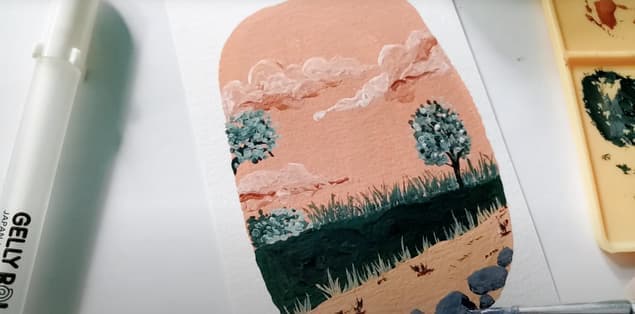
Gouache is widely employed by commercial artists today for various types of artwork, including posters, drawings, comics, and other design work. Most animations produced throughout the 20th century used gouache paint to create an opaque color on a canvas using watercolor paint as the medium for the backdrops.
The paint layers of gouache paint dry very quickly due to the rapid evaporation of the water in it. Hence, using gouache as “poster paint” is ideal.
It is not necessary to limit one’s usage of gouache to the fundamental opaque painting methods that include the use of a brush and watercolor paper. Instead, painters often use airbrushes in their applications. For example, gouache, like other kinds of paint, has been applied to non-traditional materials, such as Braille paper and cardboard.
Henri Matisse’s gouaches découpées, also known as cut collages, were made using a technique that was a departure from the conventional medium. His “Blue Nudes” series is an excellent illustration of the method. Acrylic gouache is a novel variant in the paint formulation that painters have introduced.
What Is So Special About Gouache Paint?
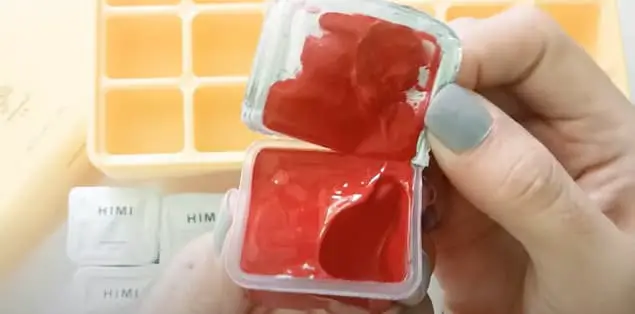
Here are some of the things that stand out in the case of a gouache paint:
Gouache is Like Watery Acrylic
Gouache is a paint that falls between watercolor and acrylic in terms of appearance. As a paint, you may either water it down to resemble watercolors or applied thickly for a thicker effect. Gouache, as opposed to acrylic, is water-based, making it easier to work with if you need to go back and make adjustments. The flip side is that you must exercise caution when adding layers since more liquid will cause the colors to blend and result in a nice brown splotch on your page.
You Don’t Have to Be an Expert to Get Started
You don’t need much to get started. Just go out and get some gouache paints and several varying-sized synthetic brushes (I like the synthetic hairs since they allow for a cleaner line). As long as you have red, yellow, blue, and white gouache, you’ll be able to get started with a small selection of paints.
Incredibly Vibrant Hues
Constructing a collection of gouache is possible after you’ve mastered the technique. For gouache, I use Winsor & Newton Designers, Arteza Premium, and Holbein Acryla. The latter is more challenging to locate, but it’s worth the effort if you can. The pigment quality whether they are natural or synthetic pigments and the color payoff of these specific brands are exceptional, and the paints themselves are a joy to work with.
There Is Little to No Waste
You don’t have to worry about wasting paint since gouache is water-based, which is a big plus because it isn’t the cheapest of painting supplies. So don’t worry if you unintentionally put too much gouache on your palette; you can add some water and mix it in and use it again.
You Can Produce Stunning Images
Gouache is a fantastic medium for creating intricate and beautiful textures. For those just starting, the drybrush method is straightforward. You may get this effect by delicately brushing your chosen color onto the paper after adding just a little amount of water to it. Use this method to get a bristly look for painting fur or hair. You can achieve delightful and life-like aspects to dog or cat hair by using this technique while painting pet pictures.
With Gouache, Layering Is a Breeze
Adding layers to gouache paintings is a lot of fun because of the medium’s high degree of transparency. When painting using this method, you can add layers of light on top of dark and vice versa. Because gouache is water-based and readily handled, you must be cautious not to disturb the paint underneath. Using less water when mixing the colors you want to apply on top of the paint you’ve previously set on is a good idea to prevent ruining it.
Gouache dries so quickly that you don’t have to wait as long between layers as you would with acrylic painting, which might take a long time to dry.
The Blooms Are Crazy
Water-based implies that you may obtain many of the same effects as watercolor. Blooming is excellent for creating a washed-out, hazy impression using watered-down colors. First, create a very light base color by smearing it on some water and then adding other colors to it. Colors begin to melt and blend when you do this. Foliage and flower paintings benefit significantly from this approach.
Portraits Are Powerful
For portraiture, gouache is a fantastic medium. You may paint portraits with many personalities by using opaque blocks of color. Painters may achieve modern and humorous portraits by painting features and accessories in bright colors.
Gouache Lends Itself Well to Photography
Because we’re also self-employed illustrators, we have to take photos of our work regularly to present to customers or upload them to my website or Instagram. As a result of its matte finish texture, gouache is an ideal medium for this project. Colors usually seem bright in pictures because there is no glare or reflection from the paint surface.
What Is the Difference Between Gouache and Acrylic Paint?
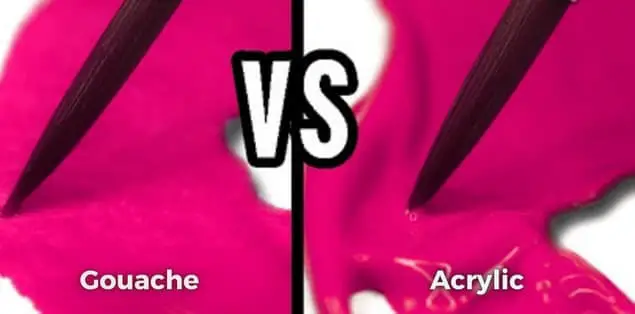
Acrylic paint and gouache are not the same mediums. Gouache is a kind of paint that is thinner and less long-lasting than acrylic paint, which is more robust and can withstand dust, light, and water. Acrylics are also outstanding for use with various other materials, including wood, paper, glass, and plastic. Gouache, on the other hand, works very well when applied to paper.
Unlike acrylics and oils, you cannot apply gouache so thickly that it generates surface roughness. This is another limitation of the paint(Gouache cracks if it is applied too thickly). Acrylics, on the other hand, may be applied using a variety of instruments, including a palette knife, in contrast to gouache, which painters usually do with a paintbrush.
Acrylic, in contrast to gouache, cannot be re-wet and manipulated; once it has dried, there is no way to alter it (although you can paint over it). Gouache is a paint that can be reactivated and altered by re-wetting the surface. Because of this, it’s a flexible and forgiving medium to work with.
What is the Difference Between Gouache and Watercolor?
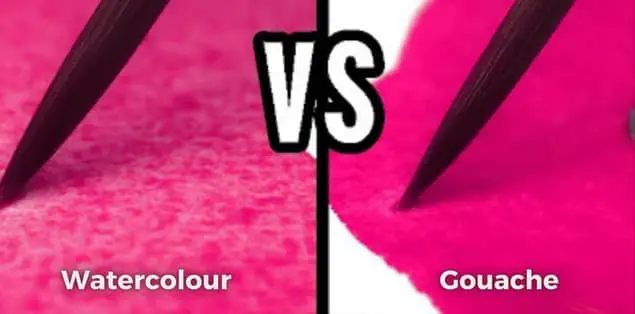
Manufacturers produce watercolor and gouache with the same fundamental elements, yet they differ significantly.
The pigments in watercolors are so minute that painters may apply the paint so thinly that it seems almost translucent. Unlike watercolors, gouache is heavier, denser, and more opaque as it dries because it contains bigger particles and more bodies than watercolors. Flat washes of color that dry matte are ideal for this paint. Gouache is an excellent painting medium that emphasizes movement, activity, and directness because of its rapid drying time.
Although gouache may be re-wetted and adheres to the paper it’s painted on, unlike watercolor, you cannot water down gouache colors to seem more transparent. Instead, gouache is not a medium that allows artists to build up paint layers the way watercolor does.
The artist John Levitt explains, “If you are a conventional transparent watercolor painter, then gouache is probably not for you. “A gouache is a superb tool if you want to explore and experiment when painting.” Creative approach is described by him as “risky and unexpected” since he builds up portions of the painting before effectively deconstructing and rebuilding them. You may “infinitely” modify your gouache paint with a moist brush, making it ideal for this kind of reconstruction.
Is Gouache Good for Beginners?
Yes, gouache is good for beginners.
What Paper Is Best for Gouache Paint?
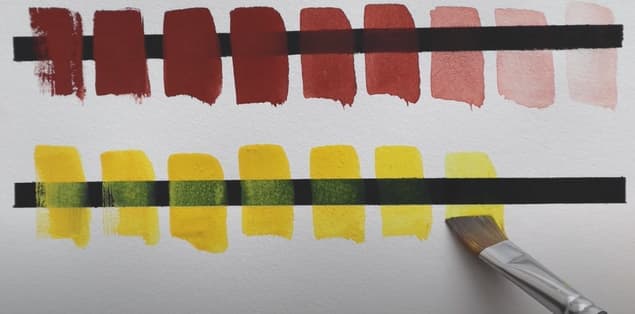
The ideal paper for gouache is substantial enough to absorb the paint without tearing.
The paper specifically designed for use in artistic endeavors should be the one you go for. Avoid using craft-style paper like cardstock whenever possible. This comes highly recommended. While it dries, it will bend, and the colors won’t seem as vibrant as they were wet.
When selecting paper for gouache, there are a few things to keep in mind:
Water Usage
Gouache requires thicker paper because of the high water content. We suggest using watercolor paper in this scenario. In order to prevent the paper from buckling, do this.
Bristol board may be used in place of the more traditional mixed media paper since it requires less water to create.
Paper Texture
Paper texture is another particular favorite of ours. It is common for the watercolor paper to have a smooth surface (cold press).
Hot press watercolor paper, mixed media paper, or bristol board are all good options if you want a smoother surface.
Sketchbook or Loose paper
Since it keeps everything neatly organized, we like drawing in sketchbooks. However, if you want to exhibit or sell your art, you’ll need loose paper.
Final Words
Gouache paint is not only entertaining but also practical and one of a kind. Learning to use gouache will provide you with an expanded toolbox of creative avenues to explore, not only because it is a historically significant media but also because you may use it on its own or in combination with other materials.
